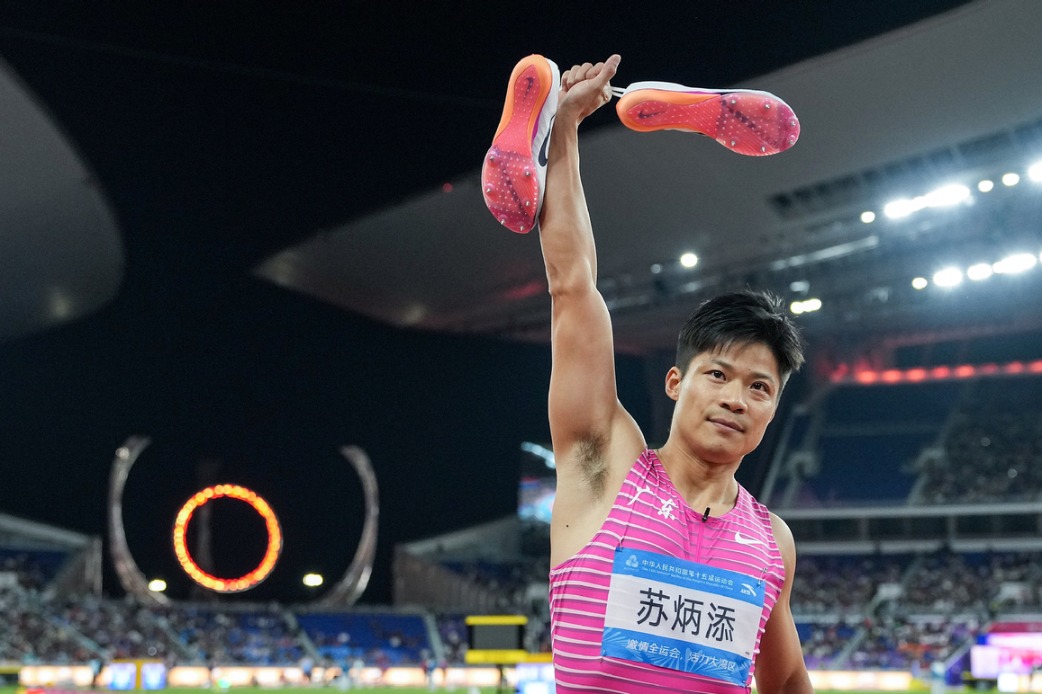They run these streets

Parkour pounces on the walls and ledges of Beijing 在鳞次栉比的高楼大厦间恣意穿行、奔跑和跳跃
They're like today's superheroes, scaling walls, jumping off buildings and defying gravity. To the rest of the world, it's called parkour, but in Chinese, it's called paoku (跑酷 páokù). The phrase literally translates to "cool running". Not to be confused with the film Cool Runnings, the phrase means: "Hey man, those are some cool kicks."
The origins of the sport trace back to France in 1988, where it was started by David Belle in Lisses, a Parisian suburb. Inspired by indigenous people on a trip to Africa with his father, he watched their movements as they interacted with their surroundings to transport themselves from one place to another, using would-be obstacles and turning them into instruments to move their bodies forward.
When Belle returned to France, he and some friends developed the sport's techniques and further enhanced their athleticism, becoming the first traceurs and traceuses (male and female parkour practitioners).
Although no single event can be cited for the entrance of parkour into China, it is commonly agreed that the sport arrived in 2006.
Co-founder of the parkour magazine, BreathePK, Matt Talbot-Turner was in Jinzhou, Liaoning province, for two years, practicing parkour in 2004 and 2005 - way before it hit the mainstream. He doesn't hide the fact that he had a tough time going about it back then.
"Practicing in China was difficult for me because there was no structured community to join. No gyms or groups. And because most people still didn't know what it was. Jumping off of buildings and structures was frowned on by a lot of people who encountered me doing it."
The sport grew quickly after 2006, but in China, back-flipping, villain-fighting heroes were nothing out of the ordinary. Chinese culture already had wushu (武术), wuxia
(武侠) and kung fu; forms of martial arts that - at least in the television shows - already demonstrated flying fight scenes.
After moving to southern Guangzhou and fastforward almost a decade later, Talbot-Turner says definitively that parkour in China is about to explode.
One benefactor of the parkour popularity boom is 21-year-old Cheng Wei. Cheng had been practicing kung fu since he was a little boy before he began training with Parkour Commune, one of the two parkour teams in Beijing.
Parkour Commune, along with Urban Monkeys, make up the two big teams in Beijing. Gao Ke leads Parkour Commune, the team that Cheng practices with most Sundays in a plaza by The Place in Jintaixiqiao. The plaza is partly owned the by a Frenchman who enjoys and recognizes the growing popularity of parkour in China.
Gao first learned about parkour in 2007 after watching a video of David Belle, and has been hooked ever since. He has been practicing for about six years and now coaches people who want to get into the sport.
"In my opinion, parkour is first useful," he says. "If you get into a dangerous situation, you can leave quickly and save yourself. Also, it's useful for the body. You don't need to go to the gym; you just train outside.
"Lastly, it builds creativity. It requires more imagination. You can also learn about the connection between the human body and the building, the connection with the body and the city."
As with most extreme sports, the issue is always safety first. After the death of a parkour enthusiast in the southwestern province of Sichuan in April this year, parkour has received negative attention as a foolhardy youth pastime.
"The first thing I tell a new person who wants to practice parkour is to keep safe," Gao says.

However, Gao says that it is your body's internal balance that is most important.
"Some people have some imbalance in the body, then they do parkour, so they injure themselves. I think the basic step is that they should rebuild the body's balance. Then you can train for muscle endurance, then strength, and then power, speed, velocity, agility; then, finally, parkour technique."
Still relatively unknown, but growing in popularity, Gao is concerned about the way parkour is developing.
"The development of the parkour environment still has a long way to go," he says.
"First, Chinese people don't know how to practice it correctly and they can injure themselves."
When talking about competitions, Gao says: "My thinking is quite Chinese, but I think all things are shuangrenjian (双刃剑), a double-edged sword. If you have a competition, it will really spread the word about it and help people become aware of it.
"But if some people just know parkour as something in a competition, its really bad. Some young guys who just go into parkour to compete will end up hurting themselves."
Sponsored competitions, such as the Red Bull National Parkour Tournament, haven't had the easiest time breaking into the market. Beginning in 2009 and held again in 2011, the competition fizzled out before it could fully gain steam.
"Red Bull pulled out following a partnership change with a major parkour group due to a poor working relationship," says Talbot-Turner, though he refuses to name names. However, he is still optimistic about bringing other big events to the country.
"The Red Bull Art of Motion (competition) currently runs in other parts of the world on a regular basis. My company would be very interested in bringing it to China. With my experience living in China, we'd be the right ones to do it."
Gao though remains unconvinced that the positive impact of competition outweighs the negative.
"I think the first time I met them, I thought it was all for money," he says.
"I told the sponsor, you need more places to teach basic parkour techniques in the competition," he added, citing the dangers of poor training.
He says of the majority of the people he has coached over the years: "They will learn for about one to two months, then they will disappear. They only know that parkour is about cool flips and some difficult movements. When they come here, they say, ‘Oh it's just some basic training.' Then they leave.
"Many people come and go; they disappear."
Parkour practitioner Cheng Wei agrees. "The hardest thing about parkour is the most important: the basics. The basics are the foundation and so you have to learn them well," he says.
"You need patience to make sure you are in good condition first."
However, not everything is doom and gloom for traceurs and traceuses with competitive spirits in China.
"They (the sponsors) want to develop parkour, but they have no suggestions, no method to develop and train," Gao says.
So in a best-of-both-worlds solution, he has teamed up with competition sponsors and the Chinese government to further develop parkour in the country, hoping to bring adrenaline-pumping, death-defying stunts in a way that promotes safety.
But it seems there's no stopping the infiltration of parkour into the media. The increased exposure on the Internet has attracted many who would otherwise be unlikely to try the sport out, such as 24-year-old Ou Langlang.
Ou has been training for a little more than a week but is keen continue. He found videos online of foreign traceurs and decided he wanted to try it himself.
"I wanted to learn because I like freedom," he says.
It seems that the future of parkour in China is full of possibilities, though there are a few key things that it still needs to really take off.
"The first thing it needs is a dedicated parkour gym. This would give it a home and a foundation for athletes to group around. Having a gym in place does wonders for building the community," Talbot-Turner says.
Courtesy of The World of Chinese, www.theworldofchinese.com
The World of Chinese
| A parkour practitioner back flips and leaps over a fence. Provided to China Daily |

(China Daily Africa Weekly 11/08/2013 page27)
Today's Top News
- China not necessarily relying on Nvidia for chips, ecosystem
- Beijing, Berlin eye productive relationship
- Para-games show commitment to inclusion
- HK election hailed as a milestone for democracy
- Mind the financing gap in infrastructure
- Is embodied AI hype or hope?































